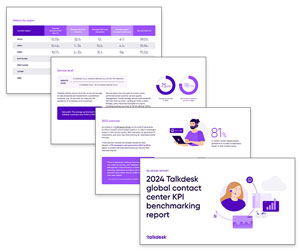Orit Avital explains the basics of KPIs (Key Performance Indicators) before introducing us to KPAs (Key Performance Areas).
What Are Contact Centre KPIs?
A Key Performance Indicator (KPI) is a value that can be calculated as a measure of how well an organisation is performing against its key objectives.
In the contact centre, we implement and assess the results of a number of different KPIs to attain a picture of how well our operation is performing.
KPIs can be split into three separate categories:
Real-Time KPIs (e.g. Service Level) – These KPIs provide an immediate view into the demand of the contact centre and they are important to track to ensure contact volumes are under control and that resources are being well utilised.
Historical KPIs (e.g. Forecast Accuracy) – These KPIs provide historical data that helps the contact centre to better plan for the future, so it can better prepare for future demand.
Customer KPIs (e.g. Customer Satisfaction) – These KPIs create a picture of how well received your service is by your customers.
Each category of KPI will likely compromise a combination of indicators that are relatively simple to measure. However, there are more complex KPIs that you can measure, depending on the technology at your disposal.
For example, with a speech analytics system, you can measure emotion through sentiment analysis. But we need to remember that we shouldn’t measure something just because we have the tools to do so.
We decide on the KPIs we measure through the assessment of those that are directly and closely connected to the broader organisational strategy.
We decide on the KPIs we measure through the assessment of those that are directly and closely connected to the broader organisational strategy. These KPIs then assist us in quantifying how well we are doing in terms of fulfilling this strategy.
However, KPIs are only indicators – they should not become an objective, as if we just focus on improving a KPI, we are not concentrating on what we are doing to improve that score and whether it’s in the best interests of our customers.
The Three Golden Rules of Using Contact Centre KPIs
As contact centre managers, setting targets and understanding their underlying significance and methods of implementation are highly important.
With this in mind, here are three golden rules that we need to remember when using KPIs in the contact centre.
- KPIs are measured with respect to a predefined set of targets.
- They must be structured and selected methodically and thoroughly, with a direct and close connection to the broad organisational strategy.
- Identify which measures can be taken down to an individual level, as this may help to identify any leading/weak components in the operational chain of performance. Also, using customer metrics at the advisor level will help you to identify individuals that deserve reward and recognition.
A List of Contact Centre KPIs
Below is a list of contact centre KPIs, split into three categories: real-time KPIs, historical KPIs and customer KPIs – some of which may appear in multiple categories, as they have more than one function.
For example, it is important to measure your historical abandon rate for WFM processes and it’s also good to measure in real time as it can add perspective to a declining service level.
| A List of Contact Centre KPIs | ||
|---|---|---|
| Real-Time KPIs | Historical KPIs | Customer KPIs |
| Abandon Rate | Abandon Rate | Customer Effort |
| Absenteeism | Absenteeism | Customer Satisfaction |
| Advisor Availability | Attrition Rate | First Contact Resolution |
| Average Speed of Answer | Average Handling Time | Net Easy Score |
| Average Time in Queue | Forecast Accuracy | Net Emotional Value |
| Occupancy | Sales Volume | Net Promoter Score |
| Service Level | Schedule Adherence | Quality Scores |
| Utilisation | Advisor Satisfaction (important for providing great service) | |
There are also channel specific metrics that we haven’t included in this list. For example, for live chat you could also monitor the following KPIs:
- Number of Chats Queuing
- Number of Elevations
- Number of Concurrent Chats
- Chat Engagement
- Number of Chats Handled
- Average Number of Chats
- Pop-up Acceptance Rate
To find out more about the live chat KPIs, read our article: Which Metrics Are Best for Monitoring Live Chat?
What Are KPAs?
Up until now, we have discussed how KPIs are an indicator of success. These indicators help us to define primary areas in which development is required to reach “success” – otherwise known as Key Performance Areas (KPAs).
So, while KPIs direct managers and advisors to an expected performance level in terms of numerical values, KPA refers to other fields for development, where we do not have enough tools and/or knowledge in order to set a numerical target for a result.
One way to think of KPAs is that they are the areas for development which our KPIs have alerted us to.
With this in mind, one way to think of KPAs is that they are the areas for development which our KPIs have alerted us to.
The Four Keys of Contact Centre KPAs
- KPAs allow/require us – for both the individual and the team (depending on the managerial level) – to aim for excellence, broader objectives and significant breakthroughs.
- KPAs allows us to define areas in which progress is important for the upcoming year, even if they do not include a tangible target.
- KPAs must be translated into primary fields in which the contract centre is responsible to create exceptional strategic results.
- KPAs will ideally be shared with other departments, so they know the areas in service that you are looking to improve – as it may impact their plans.
KPAs Don’t Have Quantifiable Targets
KPAs do not have a quantifiable target, because this is an area for development and not a grade which has to be reached.

KPAs do not have a quantifiable target, because this is an area for development and not a grade which has to be reached.
This is a statement of intention and managerial orientation for the contact centre manager and for the intermediate management level, regarding directions in which they must take the contact centre in the new year, and in which they must shine and innovate.
Different Contact Centre Departments Will Have Individual and Collective KPAs
In a company which operates sales and service contact centres, each of the different managers will have different KPAs related to the fields for which they are responsible.
The customer care contact centre will have KPAs in the field of innovation in service defined for them, in addition to the KPIs to which the contact centre is committed. Whereas the sales contact centre manager will have KPAs actually increasing the company’s product/service share with existing customers.
However, the two departments may then share a collective KPA of improving friendliness/courtesy while on the phone, for example.
How Does a Manager Set KPAs?
After the contact centre manager creates/receives the KPIs and KPAs for the upcoming year, they and – for the sake of this article – you need to create a plan for how you can improve your chance of success in these KPAs.
First, you need to work out which KPIs are related to which area of development and use these measures as insight into how successful you are in improving your KPAs.
You need to work out which KPIs are related to which area of development and use these measures as insight into how successful you are in improving your KPAs.
Then, define the KPAs for those reporting to you, so the whole contact centre team is aware of what they can do to reach the wider organisational goals.
For example, if one of the KPAs defined for you is to increase advisor knowledge:
For the coach, you will define what each advisor is expected to know and give them support in ensuring that every advisor’s knowledge matches these expectations.
For the team leader, you will share methods of retaining professional knowledge among advisors and create routines to help build advisor knowledge.
For the operations manager you will discuss ways of improving knowledge management, ensuring they have the necessary resources available to do so and that advisors know how to properly navigate the current/future knowledge management system.
These are of course only some of the KPAs which will be defined for those in these roles, but it is important to make sure that roles that you assign to them are related to their job definitions.
Create a KPA Action Plan
Creating an action plan is the best way to achieve success in your KPAs. In the example above, we could help the coach, team leader and operations manager to reach their goals by:
- Working with them to define new procedures / create new routines
- Creating a communication loop to feedback progress to the manager
- Developing new “painless” additions to common work processes
But whatever you do when it comes to defining new KPAs, keep in mind the following three pieces of advice:
- KPAs usually address broad aspects of the performance level and cannot always be directed into quantifiable results.
- KPAs intensify our focus on key organisational goals. So, while a team leader will still have a main task of meeting monthly sale targets, they’ll also receive a KPA from an important but completely different field.
- In setting KPAs – it is important to specify the wider goal, so that the team understand what they’re working towards. Connect them to the broad picture in order to make it easier for them to meet the KPAs which were defined.
While these are three key points, there is one other that you must not forget…
Do Not Define What Success Will Look Like in Terms of KPI Results
When a KPI becomes a target, we lose focus on solely improving the KPA – which is the wrong thing to do.
Why? Here are three reasons:
- Because we don’t always know exactly how we want the end result to appear
- Because the definition of an accurate result already makes the issue into a KPI and thus limits the possibilities of growth and development
- Because improving KPAs is not always our full focus; we only wish to motivate progress therein and, therefore, there is no room for it.
In Summary
When defining annual targets for managers, team leaders and advisors in the contact centre, we want to show them why these targets are important and link them to the organisational goal.
KPAs allow us to set broader objectives for the contact centre team. We should not set KPI targets, but we just want to create an action plan for how we can improve customer success in that area.

Orit Avital
Alternatively, KPIs simply provide a helpful measure to demonstrate our progress in each KPA. Just remember that they should not become targets.
So, from the level of the advisor to the level of the contact centre manager, it is recommend that you define KPAs for success and not only KPIs.
Good luck!
Thanks to Orit Avital at Ottorita for sharing this article with us.
For more articles on the topic of Key Performance Indicators/metrics, you can also read the following:
- 32 Contact Centre KPIs That You Need to Track (And Why!)
- What Are the Industry Standards for Call Centre Metrics?
- Contact Centre Metrics: Are You Measuring the Right Things?
Author: Orit Avital
Reviewed by: Megan Jones
Published On: 18th Mar 2019 - Last modified: 22nd Aug 2024
Read more about - Call Centre Management, Key Performance Indicators (KPIs), Measurement, Metrics, Orit Avital, Team Management




































